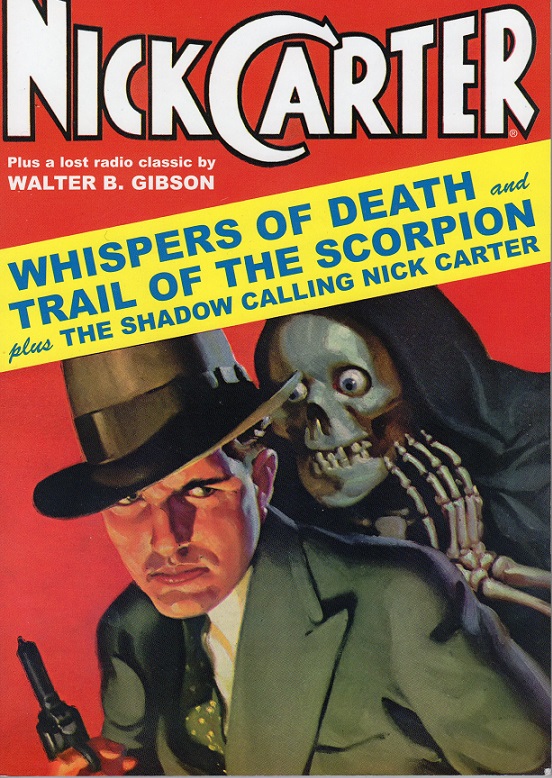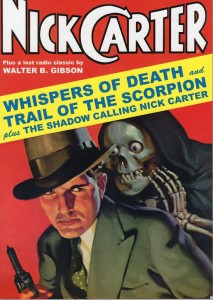Book Review: Nick Carter Volume 2 edited by Anthony Tollin
As noted in my review of the first volume, Nick Carter, Master Detective, was a long-running character who had three distinct phases. These reprint volumes primarily cover his pulp magazine career. The stories were written under the house name “Nick Carter,” even though they weren’t in first person.
“Whispers of Death” by John Chambliss leads off the volume. A Presidential Commission has met to decide if New York should have a federally-run electric power distribution system, ala the Tennessee Valley Authority, (still new in 1935 when the story was written.) They’ve made their secret decision and sent it off to Washington so that the President can announce it in four days’ time. But Mr. Ballard, the head of the commission, suspects something has gone wrong, and calls Nick Carter in for a consultation. By the time Nick arrives, Ballard has been murdered!
The government orders Nick to keep this murder a secret, even from the police, so that the public won’t panic about what this means for the power industry. This hampers his investigation considerably, although it’s clear that whoever the murderer is, Ballard knew them and it is almost certainly something to do with the commission’s decision. And therefore the other members of the commission are the main suspects!
Nick Carter and his closest associates soon discover they’re up against a “whisper gang” that uses cleverly planted rumors to manipulate markets. But who’s behind the gang? They’ll need to do a lot of shooting, fist-fighting, escaping from death traps and, oh yeah, actual detective work to figure it out.
Of note is that the writer apparently was not aware of FDR’s physical limitations (or, since the President is never named, we are in an alternate universe) as he has him walking around freely.
There’s a touch of period ethnic stereotyping and sexism (it’s mentioned a couple of times how surprising it is that Nick’s female assistant Roxy is a competent operative.)
“Trail of the Scorpion” is by Thomas Calvert McClary, who also wrote “The Impossible Theft” in the first volume (and which is referenced in this story.) Nick Carter receives a visitor who’s tattooed in a code known only to himself and one other person (who is not the person with the tattoo.) A messenger will soon arrive beating a ring engraved with a scorpion, and the fate of far Iraghan hangs in the balance.
The identity of the story’s villain is quickly revealed, an usurper named McClelland, but the mystery is where that man hid the gold he looted from Iraghan’s treasury before he was expelled from that country. Mixed up in this somehow is a con artist named Winnie the Weeper. But is she working for McClelland, against him, or just for herself?
Nick gets into a lot of narrow scrapes in this one, having his guns and tools stolen more than once, and taking more head trauma than could possibly be good for him. The trail takes him to Valdosta, Georgia and from there deep into the Everglades.
There’s a lot of outdated ethnic stereotyping in this one, as McClelland is an equal-opportunity employer–to the point that one of the minor characters is known as “the Caucasian.” There’s also some torture by the bad guys.
Another note for both these stories is that Nick Carter doesn’t get paid for either of these adventures, nor does he ever discuss his finances.
“The Voice of Crime”, an episode of the radio show version written by Walter B. Gibson (The Shadow) and Edward Gruskin, on the other hand, has Nick hurting for cash. Enough so that when a safecracker known as “Vox” offers a $10,000 reward if Nick Carter can capture him, Nick is all too willing to take the too clever for his own good criminal as a client. One gets the feeling that Nick really enjoys letting Vox think he’s outsmarted the master detective before puncturing his balloon.
“The Shadow Calling Nick Carter” is also by Walter B. Gibson with artist Charles Coll, an adaptation of the radio episode just mentioned in comic book form to turn it into a crossover with the Shadow. It’s very slight, but a rare crossover by one of the original writers of the Shadow character.
Both of the magazine stories are very exciting, though the second one may have too many racist undertones for some readers. Recommended for pulp fans.


